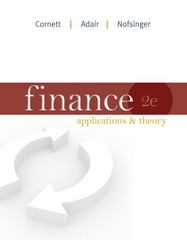Question
Face Value Coupon Rate Maturity Years to maturity Rate of return Future Value Payment Present Value $48,000,000 4.5% 1997 5 10% $1,000 $45 $791.51 $32,000,000
| Face Value | Coupon Rate | Maturity | Years to maturity | Rate of return | Future Value | Payment | Present Value |
| $48,000,000 | 4.5% | 1997 | 5 | 10% | $1,000 | $45 | $791.51 |
| $32,000,000 | 8.25% | 2007 | 15 | 10% | $1,000 | $82.50 | $866.89 |
| $100,000,000 | 12.625% | 2017 | 25 | 10% | $1,000 | $126.25 | $$1238.27 |
Assume that you plan to keep your money invested, and to reinvest all interest receipts, for five years. Assume further that you bought the 5-year bond for $800, and interest rates suddenly fell to 5 percent and remained at that level for five years. Set up a worksheet that could be used to calculate the actual realized rate of return on the bond, but do not (necessarily) complete the calculations. Note that each interest receipt must be compounded to the terminal date and summed, along with the maturity value. Then, the rate of return that equates this terminal value to the initial value of the bond is the bonds realized return. Assume that the answer is 9.16 percent. How does that value compare with your expected rate of return? What would have happed if interest rates had risen to 15 percent rather than fallen to 5 percent? How would the results have differed if you had bought the 25-year bond rather than the 5-year bond? Do these results suggest that you would be better off or worse off if you buy long-term bonds and then rates change? Explain.
Step by Step Solution
There are 3 Steps involved in it
Step: 1

Get Instant Access to Expert-Tailored Solutions
See step-by-step solutions with expert insights and AI powered tools for academic success
Step: 2

Step: 3

Ace Your Homework with AI
Get the answers you need in no time with our AI-driven, step-by-step assistance
Get Started


